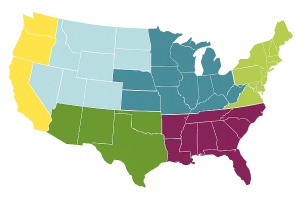South Carolina Native Plants, State Flower & State Bird
Posted By American Meadows Content Team on Sep 27, 2012 · Revised on Oct 26, 2025

Knowing your location helps us recommend plants that will thrive in your climate, based on your Growing Zone.
Posted By American Meadows Content Team on Sep 27, 2012 · Revised on Oct 26, 2025
Native plants are adaptable, low-maintenance, and beautiful. They are the best choice for habitat-friendly gardens and thriving ecosystems. Find top picks for native plants in your state - and learn about your state bird and state flowers!
Follow Along With More Of Our Guides
Hello native plant enthusiasts! In the list below, you will find popular native plants and wildflower seeds, available from American Meadows, that have a native distribution in your state. You’ll also find information about your state bird, state flower, and state wildflower!
Grow our Native Southeast Wildflower Seed Mix!
Virginia Bluebells (Mertensia virginica)
Cliff Goldenrod (Solidago drummondii)
Showy Goldenrod (Solidago speciosa)
Wrinkleleaf Goldenrod (Solidago rugosa)
Perennial Lupine (Lupinus perennis)
Black Eyed Susan (Rudbeckia fulgida)
Giant Black Eyed Susan (Rudbeckia maxima)
Black Eyed Susan or Gloriosa Daisy (Rudbeckia hirta)
Pale Purple Coneflower (Echinacea pallida)
Yellow Prairie Coneflower (Ratibida columnifera)
Gray Headed Coneflower (Ratibida pinnata)
Butterfly Weed (Asclepias tuberosa)
Swamp Milkweed (Asclepias incarnata)
Common Milkweed (Asclepias syriaca)
White Trillium (Trillium grandiflorum)
Red Trillium (Trillium erectum)
Painted Trillium (Trillium undulatum)
Rose Trillium (Trillium catesbaei)
White Tinged Sedge (Carex albicans)
Appalachian Sedge (Carex appalachia)
Wild Strawberry (Fragaria virginiana)
Plains Coreopsis (Coreopsis tinctoria)
Lanceleaf Coreopsis (Coreopsis lanceolata)
Wild Bergamot (Monarda fistulosa)
Wild Geranium (Geranium maculatum)
Elderberry (Sambucus canadensis)
Phlox divaricata (Woodland Phlox)
Obedient Plant (Physostegia virginiana)
Red Cardinal Flower (Lobelia cardinalis)
Blazing Star (Liatris spicata)
Bottlebrush Grass (Elymus hystrix)
Muhly Grass (Muhlenbergia capillaris)
Big Bluestem (Andropogon gerardii)
Little Bluestem (Schizachyrium scoparium)
Northern Sea Oats (Chasmanthium latifolium)
Yellow Prairie Grass (Sorghastrum nutans)
Smooth Blue Aster (Symphyotrichum laeve)
New England Aster (Symphyotrichum novae-angliae)
Common White Yarrow (Achillea millefolium)
Heliopsis (Heliopsis helianthoides)

Carolina Wren ~ Thryothorus ludovicianus
This stocky songster resides as far north as Iowa, Illinois, and Connecticut in the breeding season, but in winter it withdraws farther south to the states bordering the Gulf of Mexico. It is a bird of the thicket and undergrowth, whose whistled notes seem to say tea-kettle, tea-kettle or sweet-william, sweet-william.
Carolina Jessamine ~ Gelsemium sempervirens
The yellow Jessamine is also known as an evening trumpet-flower and Carolina woodbine. This woody climber, with its glossy, evergreen foliage and bright, deliciously fragrant flowers, is a characteristic feature of moist southern lowlands, and is often planted to cover banks, fences, and trellises. Beginning in early spring, the hanging stems of the vine are covered with masses of golden-yellow flowers. The blossoms, an inch or more long, are funnel-shaped, opening to five overlapping lobes. The fruit is made up of two joined sections, each containing a great many winged seeds.
From The Wildflowers of the 50 States U.S. stamps issued July 24, 1992:

